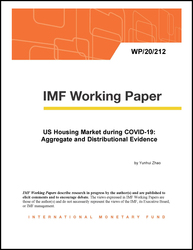
US Housing Market during COVID-19: Aggregate and Distributional Evidence
US Housing Market during COVID-19: Aggregate and Distributional Evidence
READ MORE...
Volume/Issue:
Volume 2020
Issue 212
Publication date: September 2020
ISBN: 9781513557816
$18.00
Add to Cart by clicking price of the language and format you'd like to purchase
Available Languages and Formats
| English |
Prices in red indicate formats that are not yet available but are forthcoming.
Topics covered in this book
This title contains information about the following subjects.
Click on a subject if you would like to see other titles with the same subjects.
Economics- Macroeconomics , Public Finance , WP , housing demand , housing supply , housing data , finance system , growth rates , supply composition , COVID-19 , US housing , Monetary easing , Systemic risk , Distributional effect , housing supply composition , consumption goods , housing crisis , housing price bubble , housing finance system , housing demand response , Housing , Housing prices , Mortgages , Income , Global
Summary
Using zip code-level data and nonparametric estimation, I present eight stylized facts on the US housing market in the COVID-19 era. Some aggregate results are: (1) growth rate of median housing price during the four months (April-August 2020) since the Federal Reserve’s unprecedented monetary easing has accelerated faster than any four-month period in the lead-up to the 2007-09 global financial crisis; (2) the increase in housing demand in response to lower mortgage interest rates displays a structural break since March 2020 (housing demand has increased by much more than before). These results indicate either the existence of “fear of missing out” or COVID-induced fundamental changes in household behavior. In terms of distributional evidence, I find that the increase of housing demand seems more pronounced among the two ends of the income distribution, possibly reflecting relaxed liquidity constraints at the lower end and speculative demand at the higher end. I also find that the developments in housing price, demand, and supply since April 2020 are similar across urban, suburban, and rural areas. The paper highlights some potential unintended consequences of COVID-fighting policies and calls for further studies of the driving forces of the empirical findings.
Copyright © 2010 - 2024
Powered by:
AIDC



